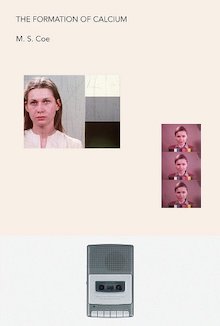
Spurl Editions, 2023
The plot of M.S. Coe’s novel, The Formation of Calcium, shares much with the real-life story of Lois Reiss, the white middle-aged Minnesota woman who, in March 2018, shot and killed her abusive husband and fled to Fort Meyers Beach where she befriended her lookalike, Pamela Hutchinson, before murdering her and assuming her identity. During what news reports described as the “manhunt” for Reiss, the FBI nicknamed her “The Killer Grandma.” For her crimes she was sentenced to life in prison without parole.
The narrator of The Formation of Calcium also murders her husband and flees to Florida, where she befriends a woman named Natalie. The two—both the same age, with bleached blonde hair—look so much alike that they’re mistaken for twin sisters. The narrator then kills Natalia and assumes her identity. As in Lois Reiss’ story, the events of the novel take place against a backdrop of marital confinement and economic hardship, in a seedy world of condos, casinos, and motels.
However, if Lois Reiss’ story provided the inspiration for The Formation of Calcium, the novel goes far beyond its possible source material, and the result is a far-reaching exploration of identity, power, and perception, charged with gothic menace throughout.
The story is told through the narrator’s audio diary. To discourage snoopers, she labels each cassette with mundane phrases like “Upholstery for Dummies” and “Natural Resources of Delaware Counties,” and it’s from one of these labels that the novel gets its title. As she records her daily activities, she remembers scenes from her youth and marriage. Her world teems with people who are not who they seem, and who change or distort their identities in order to achieve their selfish and destructive goals. A churchgoer fleeces her friends and neighbors with a BINGO scam. An exorcist is revealed as a con artist. A sympathetic daughter, a best friend, a long-lost son, a long-distance boyfriend—all hide their intentions of fraud, theft, and revenge.
But while all the characters in this novel, including the narrator, are claiming to be people they aren’t, the narrator is the only one who doesn’t seem to be pretending. Each time she changes identities, she to some extent actually becomes a different person.
The narrator’s easy shapeshifting might be a statement about the degree to which, in American culture, middle-aged women are portrayed as interchangeable and inconsequential, as stereotypical spinsters and old maids, the dead mothers of Disney princesses, the Karens of viral videos and internet memes. Many of the headlines about Reiss, who was fifty-six at the time of her crimes, followed the FBI by patronizingly referring to her as “Killer Granny” and “Fugitive Grandma,” and the reports, which tended to focus exclusively on her husband’s murder, often failed to mention Pamela Hutchinson by name. Interestingly, the narrator of The Formation of Calcium transforms similar erasures into sources of power.
She has other sources of power as well. The Formation of Calcium is filled with spirits, angels, ghosts, demons, and witches, and as the novel progresses, the narrator becomes increasingly assured of her supernatural strengths. These elements are cast in a wavering, indeterminate light. A photograph of a ghost is revealed to be a simple trick, but a childhood memory suggests that the narrator may have caused a plane crash by accidently casting a kind of spell. The spirits she encounters are almost definitely hallucinations, but their impact is important and real.
Partway through the novel, Coe introduces a true-crime podcast dedicated to tracking down the narrator. The podcast is an attempt to uncover the truth that mirrors the narrator’s own record, and both of these mirror the media reports about the real-life crimes of Lois Reiss as well as true-crime television shows devoted to that story. In this novel, truth is buried under layers of narratives, many of which exploit their subject for entertainment that reinforces systemic injustices produced by entrenched power structures. While the narrator’s actions are reprehensible, she is sympathetic, partly because her voice is so expertly crafted by Coe, and partly because her violent crimes are in some ways a desperate flailing of someone hopelessly enmeshed in those oppressive structures.
The Formation of Calcium is a compelling read, an expertly crafted thriller that’s simultaneously noir, revenge tragedy, confession, and literary fiction. Offering many satisfying surprises, this heady novel makes readers desperate to know what will happen next. It is also a scathing critique of the violence and cruelty that erupts under unjust conditions imposed upon people who are wives, or mothers, or rural, or members of the working class. Altogether it is a fascinating work of fiction, a decidedly contemporary century inheritor of works like The Story of an Hour, The Yellow Wallpaper, The Handmaid’s Tale, and Crime and Punishment that ultimately forges an identity and purpose completely its own.
+++
Born in Las Vegas, M.S. Coe is an American writer living in Guadalajara, Mexico. After she graduated with an MFA in creative writing from Cornell University, Clash Books published her first novel, New Veronia (2019). Coe’s stories have appeared in The Antioch Review, Cosmonauts Avenue, Electric Literature, Nashville Review, Waxwing, and elsewhere. She has held residencies from the Herbert Hoover National Historic Site, Petrified Forest National Park, and Ora Lerman Trust.
+
Carl Fuerst is the author of The Falling Crystal Palace (Planet Bizarro, 2023). He is a co-creator of the Deadfall, Wisconsin podcast, and he teaches writing and literature at Kishwaukee College in Malta, Illinois.